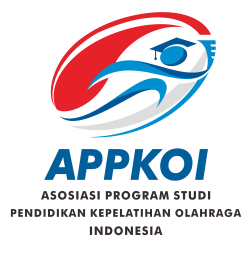Physical Condition and Achievements of the 31st SEA Games Philippines Taekwondo Athletes in the Poomsae Category
Abstract
Keywords
Full Text:
PDFReferences
Arikunto, S. (2019). Prosedur penelitian suatu pendekatan praktik.
Asakura, M. (2019). Profil Kondisi Fisik Atlet Taekwondo Kota Yogyakarta Dalam Menghadapi Pekan Olahraga Daerah Xv (Porda) Daerah Istimewa Yogyakarta Tahun 2019. Carbohydrate Polymers, 6(1), 5–10.
Bailey, R. (2017). Sport, physical activity and educational achievement–towards an explanatory model. Sport in Society, 20(7), 768–788. https://doi.org/10.1080/17430437.2016.1207756
Code, L. (2021). Introduction of Technology in the Olympic sport of Taekwondo : Cementing or sabotaging the image of Taekwondo from.
Creswell, J. W. (2014). Penelitian Kualitatif & Desain Riset Edisi 3. Yogyakarta: Pustaka Pelajar.
Erciş, S. (2018). Effects of Physical Fitness and Mental Hardness on the Performance of Elite Male Basketball Players. Journal of Education and Training Studies, 6(9a), 56. https://doi.org/10.11114/jets.v6i9a.3526
Fajrika, T., & Aulia, P. (2020). Efektifitas Latihan Mental terhadap Peningkatan Self Efficacy pada Atlet Dojang HTC Fighter Taekwondo. Jurnal Pendidikan Tambusai, 4(3), 3450–3456.
Feltt, B. (2002). Marty on the Edge.
Kazemi, M., Waalen, J., Morgan, C., & White, A. R. (2006). Combat Sports Special Issue A Profile Of Olympic Taekwondo Competitors. ©Journal of Sports Science and Medicine, 114–121. http://www.jssm.org
Kell, R. T., Bell, G., & Quinney, A. (2001). Musculoskeletal fitness, health outcomes and quality of life. Sports Medicine, 31(12), 863–873. https://doi.org/10.2165/00007256-200131120-00003
Lepers, R., & Stapley, P. J. (2010). Differences in gender and performance in off-road triathlon. Journal of Sports Sciences, 28(14), 1555–1562.
Rizkiyanto, P. P., Tirtawirya, D., & Or, M. (2019). Profil Kondisi Fisik Atlet Taekwondo Kota Yogyakarta Dalam Menghadapi Porda Xv Diy Tahun 2019 Profile Of Physical Conditions At Taekwondo City Of Yogyakarta City In Facing Porda Xv Diy In 2019. Pend. Kepelatihan Olahraga-S1, 8(10).
Sugiyono. (2015). Metode Penelitian Pendidikan (Pendekatan Kuantitatif, Kualitatif, dan R&D). In Journal Of Cleaner Production.
Yoo, S., Park, S. K., Yoon, S., Lim, H. S., & Ryu, J. (2018). Comparison of proprioceptive training and muscular strength training to improve balance ability of taekwondo poomsae athletes: A randomized controlled trials. Journal of Sports Science and Medicine, 17(3), 445–454.
Refbacks
- There are currently no refbacks.
Copyright (c) 2025 Strength and Conditioning - Exercise Science Journal

This work is licensed under a Creative Commons Attribution-NonComercial-ShareAlike 4.0 International License.

.png)









